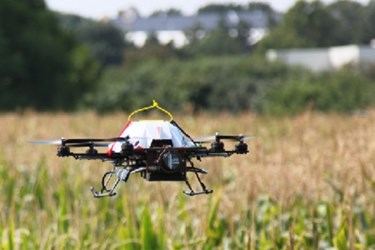How Can The Food Supply Chain Benefit From Drones?
By Melissa Lind, contributing writer

From retailer plans for home delivery of packages to the recent landings on the White House lawn, drones have captured the public’s attention. The U.S. Federal government is planning on tightening drone regulations, and while you won’t be getting any drone-delivered pizza on your porch any time soon, the technology may soon play a big role in the food industry.
Drones are already in use for surveillance purposes of border movements, port activity, public-safety reasons, environmental monitoring, and university research. While the consumer delivery plans have been nixed, drone use is ongoing and the Association for Unmanned Vehicle Systems International has stated that in the near future, agriculture may account for up to 80 percent of drone use.
Experts believe drones could be useful in several areas of the food industry’s supply chain, such as:
- Crop Monitoring — unlike satellite imagery, drones can fly close to the ground with on-board cameras that produce high-resolution imagery at the vehicle’s top speed. Drones could be used to quantify crop development and improve productivity of farm land. Drones can provide information that previously could only be measured by a drive out to the field including: plant counts, growth measurements, and soil condition evaluation. Drones can also potentially help identify and eliminate pests all the way from insects up to wild pigs.
- Herding Cattle — in the past, horses and cowboys were the primary means of herding. Many cattle farmers have also used motorcycles to herd cattle, but drones may be well suited for the job. Drones can not only help to move the herd, they can also provide information about individual animals, such as temperature and location of lost stock.
- Food Transport — pizza delivery in the U.S. may be out, but some drone experts predict that the unmanned aircraft could be used in food transport to impoverished areas. In many cases, food shortages are not so much a lack of food, but obstacles in the supply chain, particularly in remote areas or areas affected by disaster.
The Federal Aviation Administration (FAA) has proposed rules allowing it to exercise control of public drone use in the U.S. including:
- Maximum drone weight of 55 pounds
- Maximum speed of 100 mph
- Maximum altitude of 500 feet above ground with special Air Traffic Control allowances for between 500 and 18,000 feet
- Night operations are prohibited
- Operator must be 17 years of age and pass an aeronautical knowledge test
- Operator must be vetted by the Transportation Security Administration (TSA)
- Operator cannot be in control of more than one drone at a time
- Drone must be in line of sight of operator
Comment collection regarding the FAA proposed rules is ongoing and any implementation is not expected to be exercised until 2017. However, recent developments may change that schedule. In addition, though the proposed rules — particularly the weight limits and line-of-sight requirements — are prohibiting retailer use, larger drones with fewer restrictions could be utilized for international or emergency use such as food transport.
